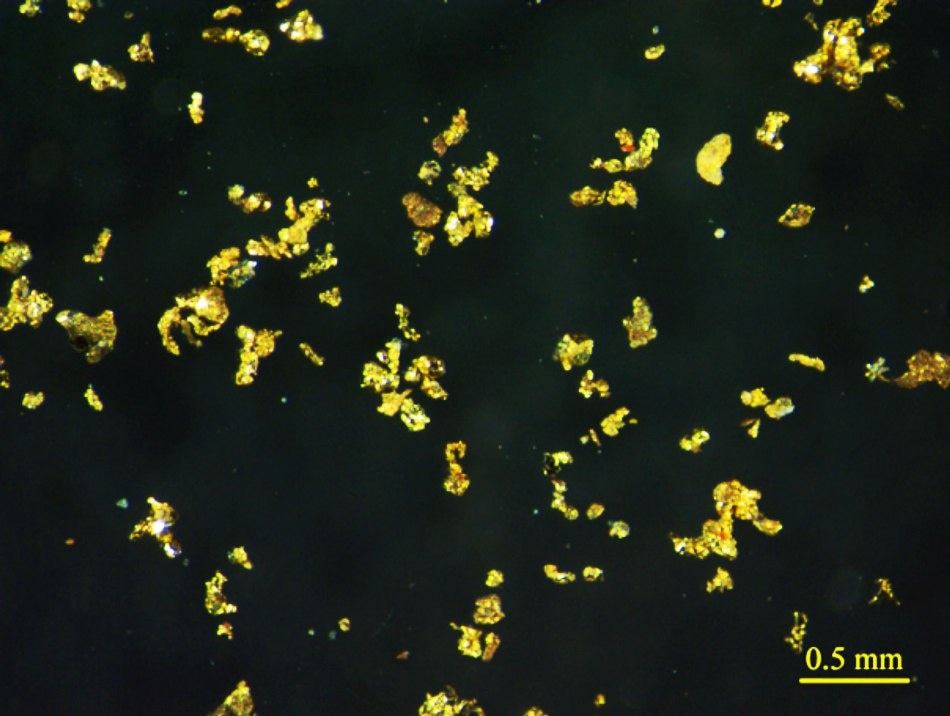Jul 18 2019
Ultra Lithium Inc. has announced the receipt of the Mineralogy Research Study Report from the Material Composition Department of Kunming Metallurgical Research Institute (KMI), China.
 Photo showing natural gold morphology phase. (Image credit: Ultra Lithium Inc.)
Photo showing natural gold morphology phase. (Image credit: Ultra Lithium Inc.)
The outcomes of the research demonstrate that the average gold content in the samples is 35.916 g/t, with 79.38% gold present in the form of an independent mineral, which can be recovered via gravity separation.
Ultra Lithium Moves Forward with Gold Projects
The research work carried out by KMI is a significant milestone for our Argentinian gold projects. This study provides a basis for designing a pilot-scale gold processing plant to determine the viability of processing mining dump material on each historical mine site.
Dr Weiguo Lang, CEO, Ultra Lithium
Lang continues, “Presence of over 79% free gold in rock samples is an important finding of the study. This will enable the Company to achieve a high recovery rate at low costs, as well as saving future capital expenditures for the processing and metallurgical test work.”
Research Highlights:
1) The mineralization includes 9 categories of 26 varieties of minerals, comprising natural elements, oxide, sulfide, carbonate, silicate, sulfate, phosphate, halide, and vanadate, among which oxide constitutes 78.86%, carbonate constitutes 7.64%, silicate constitutes 7.46%, sulfate constitutes 3.48%, and other smaller ones.
2) By powdering the mineralized rock to -0.3 mm (screening rate > 99%), the cumulative distributions of embedded particles sized above 400 mesh (0.038mm) are:
- Quartz: 99.86%
- Muscovite: 99.86%
- Chrysocolla: 99.86%
- Limonite/hematite: 99.21%
- Malachite: 99.80%
- Atacamite: 99.52%
3) The mineralized rock crushing to 0.3 mm (sieving rate > 99%), dissociation detections of fully dissociated minerals are:
- Quartz: 99.86%
- Muscovite: 51.39%
- Chrysocolla: 39.67%
- Limonite/hematite: 44.11%
- Malachite: 55.85%
- Atacamite: 21.09%
4) In samples, the average gold content is 35.916 g/t. Key minerals carrying gold are natural gold, muscovite, quartz, limonite, chrysocolla, malachite, hematite, and atacamite. Gold occurs in two forms: one in an independent form present in natural gold that constitutes 79.38%, and the other form of mechanical mixing in muscovite, quartz, limonite, chrysocolla, malachite, hematite, and atacamite (cannot be identified by optical microscope or scanning electron microscope).
5) Average copper content is 2.45%. Copper is mostly present in atacamite, malachite, and chrysocolla, and a small amount occurs in calcite, brochantite, and covellite.
6) Average lead content is 5.87%. Lead is largely present in sardianite and cerusite, and a small amount of lead is found in chervetite.
7) The gold distribution in rock is quite concentrated, with the distribution of natural gold in the main gold-bearing minerals reaching 79.38%. It is proposed that this part of the gold minerals can be mostly recovered through gravity separation.
8) The host rock predominantly contains massive structures. Some metal minerals, like hematite and limonite, are sparsely dispersed in the rock, creating a scanty disseminated structure of mineralization. The chief structure of metallic minerals is its granular structure, and the key structure of gangue minerals is unequal granular crystalloblastic texture.
9) The outcomes of microscopic observation, hand panning, X-ray diffraction analysis, MLA analysis, and electron microprobe analysis reveal that the natural elements in the rock are as follows: oxide, sulfide, carbonate, silicate, phosphate, sulfate, halide, and vanadate in nine categories of 26 types of minerals, including oxide (78.86%), carbonate (7.64%), silicate (7.46%), sulfate (3.48%), and other small amounts.
10) Analyses of microprobe and single mineral chemistry corroborated that muscovite, quartz, limonite, chrysocolla, malachite, cerusite, and hematite are the important carrier minerals of gold. Mixed rock with -2 mm particle size was taken, shrunk, and crushed to a size of -0.3 mm, and prepared into MLA resin sample for analysis. The outcomes are as follows:
- Chrysocolla—mainly 3.4–212 μm (cumulatively reached 98.86%)
- Quartz—mainly 6.8–300 μm (cumulatively reached 98.06%)
- Muscovite—mainly 3.4–212 μm (cumulatively reached 98.86%)
- Limonite/hematite—mainly 4.8–300 μm (cumulatively reached 99.21%)
- Atacamite—mainly 4.8–106 μm (cumulatively reached 98.17%)
- Malachite—mainly 6.8–150 μm (cumulatively reached 98.00%)
Grab Sample Testing
In total, three grab rock samples were obtained from dump material situated near the historical mining regions of the newly received gold mining licenses.
These samples were used for property acquisition due diligence purposes and were tested in two independent laboratories: SGS Laboratories in Burnaby, Canada, and Kunming Metallurgical Research Institute (KMI), China. In addition, Ultra Lithium requested KMI to complete a mineralogy research study.